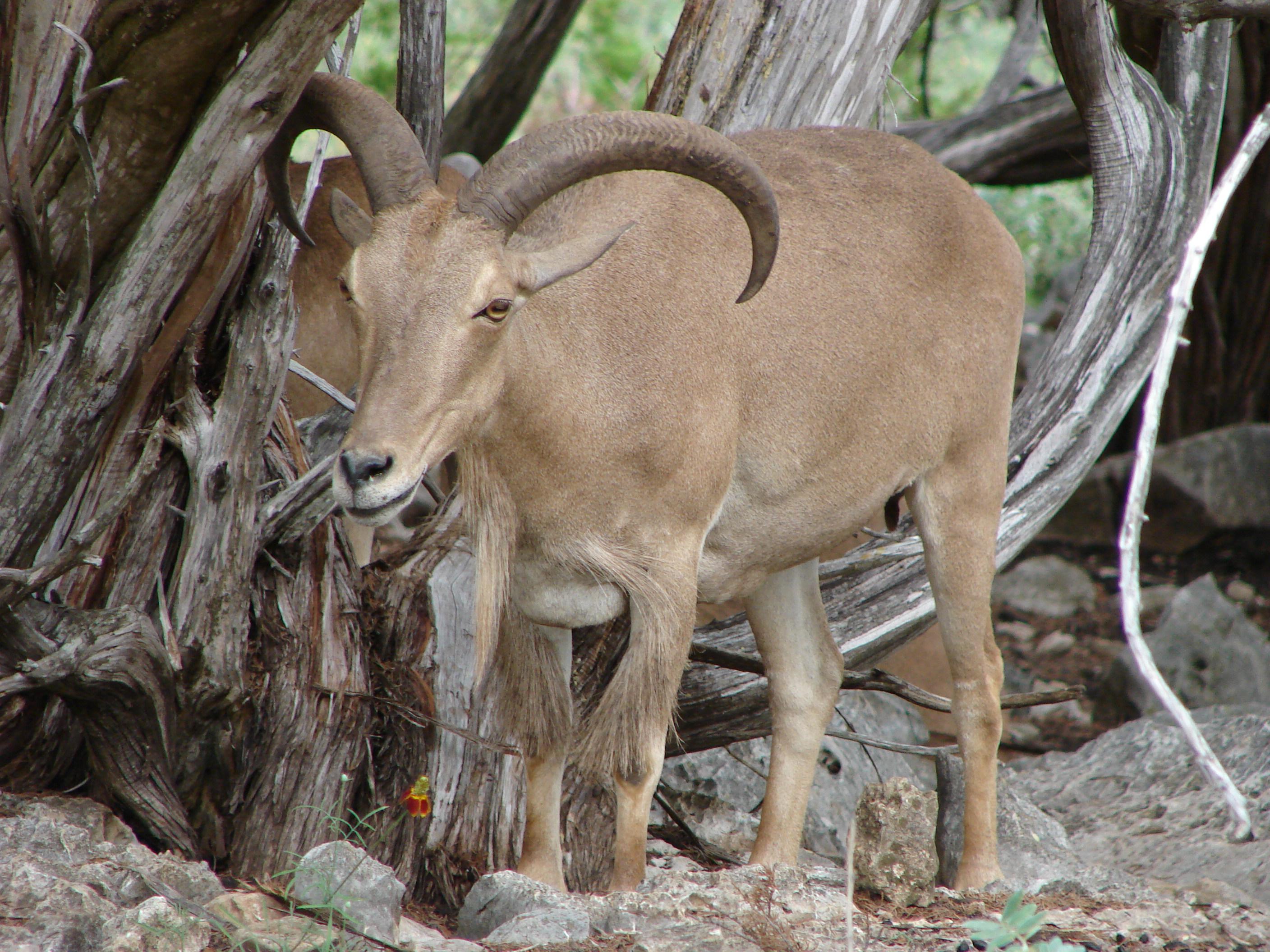- Barbary Sheep
Taxobox | status = VU | status_system = IUCN2.3
name = Barbary Sheep

image_caption = Barbary Sheep
regnum =Animal ia
phylum = Chordata
classis =Mammal ia
ordo =Artiodactyla
familia =Bovidae
subfamilia =Caprinae
genus = "Ammotragus"
species = "A. lervia"
binomial = "Ammotragus lervia"
binomial_authority = Pall., 1777
subdivision_ranks =Subspecies
subdivision = "A. l. angusi" Rothschild, 1921
"A. l. blainei" Rothschiild, 1913
"A. l. lervia" Pallas, 1777
"A. l. fassini" Lepri, 1930
"A. l. ornatus" † I. Geoffroy Saint-Hilaire, 1827
"A. l. sahariensis" Rothschild, 1913The Barbary Sheep ("Ammotragus lervia", also called Aoudad, Arui and Waddan (in
Libya )) is aspecies ofCaprinae (goat-antelope) found in rocky mountains inNorth Africa . Sixsubspecies have been described. Although it is rare in its native North Africa, it has been introduced toNorth America , southernEurope and elsewhere.Description
Barbary Sheep stand 80 to 100 cm (30 to 40
inch es) tall at the shoulder and weigh 40 to 140 kg (90 to 310 lb). They are asand y-browncolor , darkening with age, with a slightly lighter underbelly and a darker line on the back. Upperparts and outer legs are uniform reddish-brown or grayish-brown. There is some shaggy hair on thethroat (extending down to the chest in males) and a sparse "mane ". Their horns have a triangular cross section. The horns curve outwards, backwards then inwards, and reach up to 50 cm (20 inches). The horns are smooth, but wrinkled at the base. Scientists say that the horns can grow to be about six inches long.Range
Natural range
Barbary sheep are found in northern Africa in
Algeria ,Tunisia , northernChad ,Egypt ,Libya , northernMali ,Mauritania ,Morocco (includingWestern Sahara ),Niger andSudan (west of Nile and east of Nile in theRed Sea Hills )MSW3 Grubb|id=14200754] .Introduced populations
Barbary sheep were introduced into southeastern
Spain and southwesternUnited States (parts ofTexas ,New Mexico ,California ) andMexico and in some parts of Africa.The species is currently expanding in the southeastern quarter of the
Iberian Peninsula according to recent field surveys (Cassinello et al., 2004). Aoudads have become common in a limited region of the south east ofSpain since its introduction as a game species inSierra Espuña Natural Park in 1970. Its adaptability enabled it to colonise nearby areas quickly. Increasing number of Aoudads in Spanish private game estates were other centers of dispersion.Aoudads also were introduced in
La Palma Island (Canary Islands ), becoming a serious threat to endemic flora. Of great conservation concern is their potential as competitors against nativeungulate s inhabiting the peninsula. Surveys conducted in southern Spain documented rapid colonization of new areas and established viable populations, consisting of adult males and females and the unequivocal presence of nursery groups, in the provinces ofAlicante ,Almería ,Granada andMurcia . Aoudads have also spread throughout the north and centre of La Palma.There are two main conservational concerns: the necessity to conduct detailed, reliable surveys in all potential regions where the species might expand, and the urgent need to change current game policies in order to establish reliable controls on big game estates to prevent animals from escaping.
Subspecies
The subspecies are classified mainly according to their distribution in North AfricaMSW3 Grubb|id=14200754] :
* "Ammotragus lervia lervia" Pallas, 1777. (vulnerable)
*Egyptian Barbary Sheep "Ammotragus lervia ornatus" I. Geoffroy Saint-Hilaire, 1827. (extinct in the wild)
* "Ammotragus lervia sahariensis" Rothschild, 1913. (vulnerable)
* "Ammotragus lervia blainei" Rothschild, 1913. (vulnerble)
* "Ammotragus lervia angusi" Rothschild, 1921. (vulnerable)
* "Ammotragus lervia fassini" Lepri, 1930. (vulnerable)Habitats
Barbary Sheep are found in
arid mountainous areas of the Sahara where theygraze and browse all available plants --grass , bushes,lichen andacacia . They obtain all their moisture from food, but if water is available they drink and wallow in it. Barbary Sheep arecrepuscular , active in the early morning and late afternoon, resting in the heat of the day. They are very agile and can jump over two metres from a stand-still. Barbary Sheep are usually solitary, and freeze in the presence of danger. Their mainpredators in North Africa areleopard s andcaracal s.Names
The
binomial name "Ammotragus lervia" derives from the Greek "ammos" ("sand", referring to the sand-coloured coat) and "tragos" ("goat"). "Lervia" derives from the wild sheep of northern Africa described as "lerwee" by Rev. T. Shaw in his "Travels and Observations" about parts ofBarbary andLevant ."Aoudad" (PronEng|aˈuːdæd or IPA|/ˈaʊdæd/) is the name for this sheep used by the Berbers, a North African people.
Gallery
External links
* [http://www.vertebradosibericos.org/mamiferos/ammler.html A Spanish site on complete biological information about the Aoudad]
* [http://www.ultimateungulate.com/Artiodactyla/Ammotragus_lervia.html The Ultimate Ungulate entry on Barbary Sheep]
* [http://www.nsrl.ttu.edu/tmot1/ammolerv.htm Barbary Sheep in Texas]References
*Cassinello, J. (1998). "Ammotragus lervia": a review on systematics, biology, ecology and distribution. Annales Zoologici Fennici 35: 149-162
*Cassinello, J.; Serrano, E.; Calabuig, G. & Pérez, J.M. (2004). Range expansion of an exotic ungulate ("Ammotragus lervia") in southern Spain: ecological and conservation concerns. Biodiversity and Conservation 13: 851-866
*Wacher, T., Baha El Din, S., Mikhail, G. & Baha El din, M. (2002). New observations of the ‘extinct’ Aoudad "Ammotragus lervia ornata" in Egypt. Oryx 36: 301–304.
Wikimedia Foundation. 2010.
